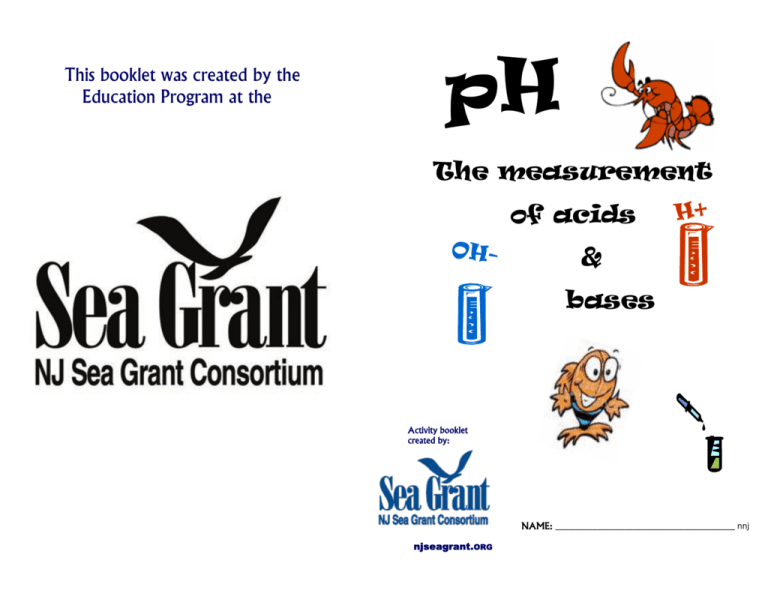pH booklet - Sea Grant
advertisement

This booklet was created by the Education Program at the pH The measurement of acids OH- H+ & bases Activity booklet created by: NAME: _______________________________________ nnj njseagrant.ORG Understanding pH The term pH comes from what scientist call the "power of hydrogen" which is the measurement of hydrogen ions (H+) and hydroxide (-OH) ions is in a solution. Depending on how many of these ions are in a solution determines if a solution is considered acidic or basic. QUESTIONS 1. What does the value of pH in a solution indicate? 2. Why are stable pH values in waterbody’s important? pH is measured on a scale from 0 to 14, with 7.0 considered neutral. A solution with a pH below 7.0 is considered an acid and a solution with a pH above 7.0 is considered a base or alkaline. 3. Explain how pH may increase in a body of water. What is neutral? 4. Explain how pH may decrease in a body of water. A neutral solution has an equal amount of hydrogen atoms (H+) and hydroxide atoms (OH-) 5. Can you think of one thing you can do to help protect a body of water from becoming too acidic or too basic? A neutral solution has a pH of 7.0 A common neutral solution is: 6. What is the tolerable pH range for most life in water? Distilled (pure) water with a pH of 7.0 7. True or False- Chemicals and minerals added to a solution can change the balance of H+ and OH- ions turning it into an acid or a base. What is an acid? Solutions that are considered acids have more Hydrogen (H+) ions than a perfectly neutral (pH 7) solution. An increase in H+ ions lowers a solution’s pH number. An acidic solution has a pH below 7.0 Solutions very high in acidity can be harmful to living organisms. A common acidic solution is: Lemon Juice with a pH of 4.0 8. A pH of 5.6 is healthy for blue crabs. 8. What questions do you still have about pH? 14.0 13.0 HOW DOES pH EFFECT AQUATIC LIFE? 12.0 What is a base? Solutions with more hydroxide (OH-) atoms than a neutral solution (pH 7) are considered bases. They are or also known as alkaline solutions. An increase in OH– ions raises a solution’s pH number. pH 11.4- Fish avoid waters beyond this limit. 11.0 A basic solution has a pH above 7.0 Solutions that are very basic can also be harmful to living organisms. 10.0 pH 10.1- Upper limit for even the most hardy fish species to survive 9.0 6.0 5.0 The pH of water pH range, 5.5-9.0- Tolerable range for most fish. pH 6.0– A value any lower than this is lethal to blue crabs this acidic pH 4.0– Lower limit for even the most hardy fish species 3.0 pH 3.8- Fish eggs could hatch but deformed young are often produced 2.0 0.0 Depending on the body of water you are testing, the pH value that is considered healthy and normal may be different. In the ocean, saltwater organisms prefer an alkaline solution with a pH of 7.5-9.0, with 8.3 optimal. Organisms that live in bays or estuaries prefer a pH value ranging from 7.0 to 8.5 with an optimal value of 8.0. pH 4.3- Carp will die with 3 days in water 4.0 1.0 Laundry detergent with a pH =10.5 pH 8.7- Upper limit for good fishing waters 8.0 7.0 A common basic solution: pH 1.0- Mosquito were destroyed at pH this low pH values in estuaries and the ocean tend to be more basic due to the salts present. in the water. Salts slightly raise the pH of the water, but they also act as a buffer. This helps water resist changes or fluctuations of pH if small amounts of acidic or basic solutions are added. Stable pH values are important to many organisms! In rivers, streams and ponds, freshwater organisms thrive at the neutral to acid end of the spectrum (pH between 5.5 and 7.5). However healthy, normal pH values may vary from location to location. Be sure find out what pH is considered healthy for the body of water you are testing. Generally pH levels below 5.5 and above 9.0 are dangerous to living organisms. Almost nothing can survive in extremely acidic or basic water. QUESTIONS: Why does pH change in a body of water? 1. What does pH measure the balance of? pH can vary tremendously when just small amounts dangerous chemicals enter a body of water. 2. pH is measured on a scale from 0 to ___?___ 3. What do you call a solution with a pH of 7.0? 4. If a solution has a pH of 9.5 is the solution an acid or a base? 5. If a solution has a pH of 3.4 is the solution an acid or a base? 6 What pH value do animals living in the ocean prefer? 7. What pH value do animals living in estuaries prefer? 8. What is a healthy pH value for freshwater organisms? Why test pH in the water? pH is a great indicator of the health of a body of water. If it's your fish tank or a river, if pH is too high or too low this is a sign chemicals are entering or reacting in the water in harmful ways that could be dangerous to living organisms. Stable pH values in the water are important to many organisms. Most organisms have adapted to life in water of a specific pH. Most shellfish, numerous species of fish and many immature stages of aquatic organisms are extremely sensitive to changes in pH. Some species are so sensitive to changes in the pH they may perish if the pH changes even slightly. Regular testing of pH is best to ensure pH levels are not fluctuating. While small fluctuations in pH can be normal, extreme changes in pH in a short period of time can be very harmful to many organisms. One of the most common ways dangerous chemicals and hazardous wastes enter a body of water is after a rainstorm. Pollutants from streets and other land areas run off into nearby waterways during storm events. Copper from worn automobile brake pads is often present in this runoff. Acid rain, which contains carbonic, nitric and sulfuric acids, can sharply lower the pH of a body of water as the rain goes through the atmosphere and runs quickly off streets into waterways. Acid rain is a result of air pollution--rain picks up the chemical pollutants present n the air as it passes through. When a waterbody becomes acidic, it not only has detrimental effects on aquatic organisms, but can also cause dangerous heavy metals such as copper and aluminum, stored in the sediment at the bottom of the waterbody, to be released into the water column. Excessive growth of algae removes carbon dioxide from water during photosynthesis. This can result in a significant increase in pH levels. Rapid growth of algae is often caused by excessive nutrients from fertilizers entering the water. As organic substances decay, carbon dioxide forms and combines with water to produce a weak acid called carbonic acid. Large amounts of carbonic acid lower the water's pH. This often happens in the autumn when excessive amounts of fallen tree leaves enter bodies of water.







